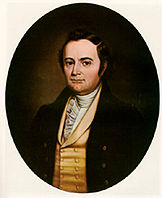United States House of Representatives elections, 1824
|
|
|||||||||||||||||||||||||
|---|---|---|---|---|---|---|---|---|---|---|---|---|---|---|---|---|---|---|---|---|---|---|---|---|---|
|
|||||||||||||||||||||||||
|
All 213 seats to the United States House of Representatives 107 seats were needed for a majority |
|||||||||||||||||||||||||
|
|||||||||||||||||||||||||
|
|||||||||||||||||||||||||
Henry Clay
Democratic-Republican
Elections to the United States House of Representatives for the 19th Congress coincided with the contentious presidential election of that year. While the bulk of states held their elections in 1824, six states scheduled their general elections at various times during 1825.
By 1823, the year that marked the end of the consensus-driven Era of Good Feelings, the national wing of the Federalist Party had disbanded and the Democratic-Republican Party, which was left as the only major political party, was being destroyed by internal divisions. The party fractured after the 1824 presidential election between those who supported the new president, John Quincy Adams, and those who supported Andrew Jackson. Jackson was defeated after the House decided the contested election in favor of Adams. Representatives who supported Adams won a slim majority in the House, and would later form the National Republican Party in 1825. Jackson supporters continued calling themselves Democratic-Republicans, and later became the Democratic Party in 1828.
The earlier distinction between Democratic-Republican and Federalist had dissolved at this time, with Representatives and Senators being grouped into Adams supporters (the Adams-Clay factions of the previous parties) and Jackson supporters (the Jackson factions of the previous parties). Crawford's supporters were divided between the Adams and Jackson factions.
...
Wikipedia


